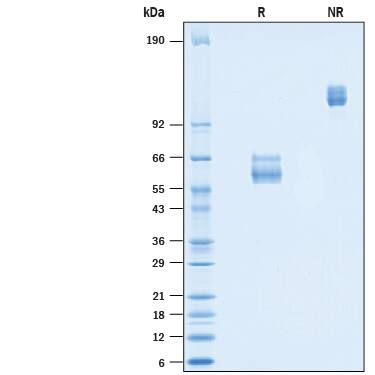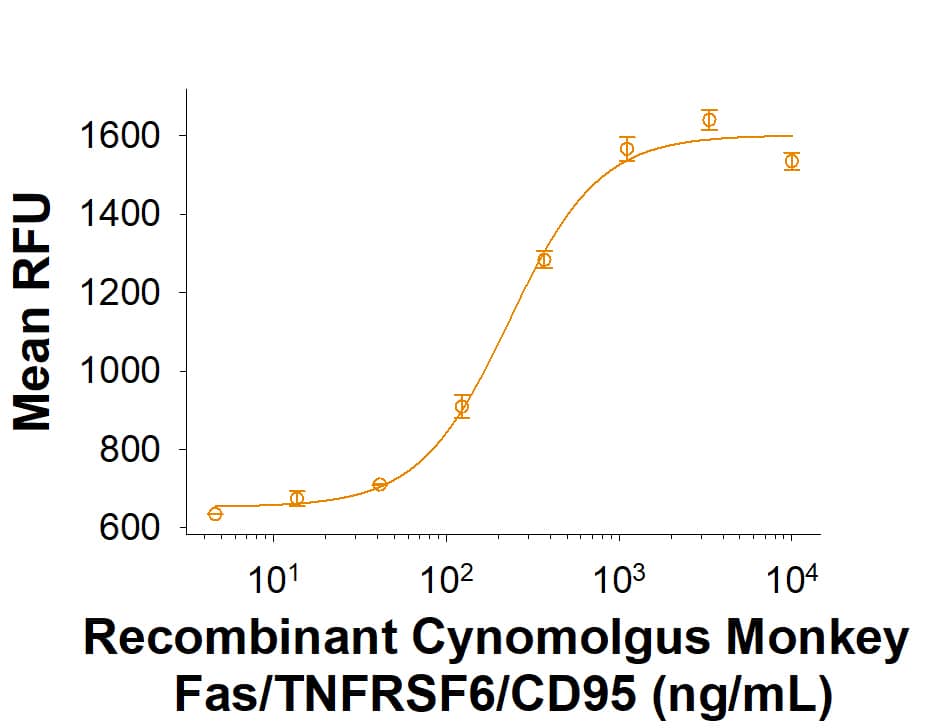Recombinant Cynomolgus Monkey Fas/TNFRSF6/CD95 Fc, CF
R&D Systems, part of Bio-Techne | Catalog # 10755-FS

Key Product Details
Source
CHO
Accession #
Structure / Form
Disulfide-linked homodimer
Conjugate
Unconjugated
Applications
Bioactivity
Product Specifications
Source
Chinese Hamster Ovary cell line, CHO-derived cynomolgus monkey Fas/TNFRSF6/CD95 protein
| Cynomolgus Monkey Fas/TNFRSF6/CD95 (Gln26-Asp173) Accession # Q9TSN4.1 |
IEGRMD | Human IgG1 (Pro100-Lys330) |
| N-terminus | C-terminus |
Purity
>95%, by SDS-PAGE visualized with Silver Staining and quantitative densitometry by Coomassie® Blue Staining.
Endotoxin Level
<0.10 EU per 1 μg of the protein by the LAL method.
N-terminal Sequence Analysis
Gln26, inferred from deblocking revealing Val27
Predicted Molecular Mass
43 kDa
SDS-PAGE
55-70 kDa, under reducing conditions
Activity
Measured by its ability to inhibit Fas Ligand-induced apoptosis of Jurkat human acute T cell leukemia cells. Cheng, J. et al. (1994) Science 263:1759.
The ED50 for this effect is 40.0-240 ng/mL.
The ED50 for this effect is 40.0-240 ng/mL.
Scientific Data Images for Recombinant Cynomolgus Monkey Fas/TNFRSF6/CD95 Fc, CF
Recombinant Cynomolgus Monkey Fas/TNFRSF6/CD95 Fc Chimera Bioactivity.
Recombinant Cynomolgus Monkey Fas/TNFRSF6/CD95 Fc Chimera (Catalog # 10755-FS), inhibits Fas Ligand-induced apoptosis of Jurkat human acute T cell leukemia cells. The ED50 for this effect is 40.0-240 ng/mL.Recombinant Cynomolgus Monkey Fas/TNFRSF6/CD95 Fc Chimera SDS-PAGE.
2 μg/lane of Recombinant Cynomolgus Monkey Fas/TNFRSF6/CD95 Fc Chimera (Catalog # 10755-FS) was resolved with SDS-PAGE under reducing (R) and non-reducing (NR) conditions and visualized by Coomassie® Blue staining, showing bands at 55-70 kDa and 110-140 kDa, respectively.Formulation, Preparation and Storage
10755-FS
| Formulation | Lyophilized from a 0.2 μm filtered solution in PBS. |
| Reconstitution | Reconstitute at 500 μg/mL in PBS. |
| Shipping | The product is shipped with polar packs. Upon receipt, store it immediately at the temperature recommended below. |
| Stability & Storage | Use a manual defrost freezer and avoid repeated freeze-thaw cycles.
|
Background: Fas/TNFRSF6/CD95
References
- Bouillet, P. and L.A. O’Reilly (2009) Nat. Rev. Immunol. 9:514.
- Strasser, A. et al. (2009) Immunity 30:180.
- Ashkenazi, A. and V. Dixit (1999) Curr. Opin. Cell Biol. 11:255.
- SwissProt Accession # P25445.
- Liu, C. et al. (1995) Biochem. J. 310:957.
- Papoff, G. et al. (1996) J. Immunol. 156:4622.
- Thorburn, A. (2003) Cellular Signaling 16:139.
- Barreiro, R. et al. (2004) J. Immunol. 173:1519.
- Ferguson, T.A. and T.S Griffith (2006) Immunol. Rev. 213:228.
Long Name
Fibroblast-associated
Alternate Names
Apo-1, APT1, CD95, TNFRSF6
Entrez Gene IDs
Gene Symbol
FAS
UniProt
Additional Fas/TNFRSF6/CD95 Products
Product Documents for Recombinant Cynomolgus Monkey Fas/TNFRSF6/CD95 Fc, CF
Product Specific Notices for Recombinant Cynomolgus Monkey Fas/TNFRSF6/CD95 Fc, CF
For research use only
